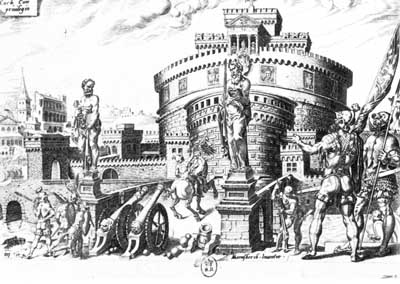12: Renaissance Rome and the Curia
In Rome: The Renaissance Curia
(Mostly) outside Rome: the Wars of Italy
The Curia: Renaissance Europe’s biggest bureaucracy (from Martin V to Clement VII)
Late Avignon era ca 500-600
1520: over 2k (including vacabilia)
Source: John D’Amico, Renaissance Humanism in Papal Rome
Chancery (Palazzo della Cancelleria)
central church (Rome) more involved in decision-making across Europe (public and private)
Another set of re-organization moves: mid 16th c
Our example: Datary (Dataria)
Established under Martin V
One of cardinals: appointed as Datarius
Annates: annual taxes from region of Europe
- Competition with taxation by territorial leaders
- New needs: urban, commercial world
Benefice-supported positions
Established in perpetuity
- Some: inadequate over time: combine (“plural”)
- Others: original position no longer exists: re-allocate
European interest in dispensations: for a fee
- marriages within forbidden degrees
- substitutes for going on a pilgrimage
- overlooking illegitimacy
- Indulgences: (“butter letters”)
| butter lamb |  |
 |
Indulgence issued by Leo X |
Naming new appointees to church positions
- Papal provision: cardinal advanced a name in Consistory (propina for services)
- Papal reservation
- “papal months” (Martin V+)
- Allowances for “exceptional” situations: plural appointments, non-resident appointments, “incompatible” benefices
- “Expectative favor” gratia expectativa —promise of a benefice not yet vacant
Ways to resign an office
- Reserving revenue as a pension
- Right to resume
- Resign in favor of a designated person (nephew)
“composition” (fee)
venal offices: all curial offices now venal
vacabilia (Sixtus IV+) annual payment @ 11% original payment
1525: annual cost ca 140,000 ducats/year, or 32 % of total papal income
banker “Depositor General” (often Medici bank)
Tension: need for funding/spiritual nature of tasks
Italian peninsula: “Wars of Italy”
Stability: Lodi 1454
Destabilization: deaths of Lorenzo de’ Medici (1492),
Ferrante of Naples (1494)
instability in Milan
Milanese faction reminds Charles VIII (Fr): claims to Naples
French army crosses Alps Sept. 1494
Did not stay but warfare continues
Pope Alexander VI: “Holy League”
- Papacy, Venice, Milan, Emperor Maximilian, K of Aragon
- Supposedly against Turks; really against Charles VIII
Louis XII of France (1498-1515) Milan 1499
1508 League formed at Cambrai against Venice (Agnadello 1509)
1511 New Holy League against French
1512 Medici return to Florence: Cardinal Giovanni de’ Medici 1513: Leo X
Last main phase: Francis I and Charles V
Francis I 1515 retakes Milan
1516 Charles inherits Spanish crown (HRE 1519: Charles V)
— French lose to HRE 1525

Sack of Rome 1527
Final phases of War:
- 1529 treaties (Barcelona and Cambrai):
- Spanish win title to Naples; end of French claims to Milan
- 1559 Treaty of Cateau-Cambrésis, 1559
- Spanish Habsburgs in much of Italy

